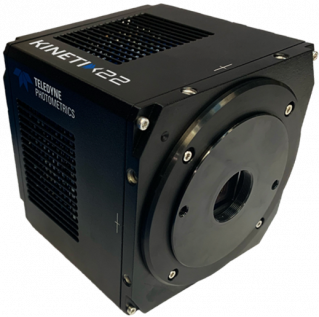OPM Snouty Light-Sheet
Mr. Jacob Lamb, Dr. Edward Ward, Prof. Clemens Kaminski
Laser Analytics Group, Department of Chemical Engineering & Biotechnology, University of Cambridge, UK
Background
Dr. Edward Ward and Mr. Jacob Lamb are both researchers in the Laser Analytics Group, led by Prof. Clemens Kaminski. This group aims to develop imaging techniques to apply to biological systems, requiring the latest in optical and camera technologies.
Dr. Ward spoke about one of their latest developments, "We use light sheet and confocal microscopy, and we needed a solution with high-speed imaging, easier sample prep, easier mounting as well as high resolution. Using single objective OPM [Oblique Plane Microscopy] Snouty allows for faster imaging at a high resolution."
By using a custom AMS-AGY 'Snouty' lens, the Kaminski Lab aim to image at a higher temporal and spatial resolution than traditional light sheet methods, obtaining volumetric high-contrast images at high speed, all with less sample prep and easier mounting due to the single-objective format. This light sheet system needs to be paired with a suitable camera in order to avoid any bottlenecks and maximize imaging throughput and efficiency.

Figure 1: Two maximum intensity projection images taken with a single-objective light-sheet imaging system including a Kinetix22 sCMOS, OptoSplit III, and OPM Snouty lens. In blue is a 200 μm x 200 μm FOV image of microtubules in Cos 7 cells using the fast galvo scanning method on the OPM. In orange is a 1000 μm x 220 μmimage of microtubules in live retinal ganglion cell axons growing out of a Xenopus laevis eye explant, using stage scanning on the OPM.
Challenge
Mr. Lamb outlined the challenges faced with their imaging system, "We want to image as fast as possible, a few volumes a second would be nice... but how fast we can image is entirely limited by the camera: by how short we can make the exposure time and still see a nice image, and by the readout speed of the camera."
"For the camera, we also need high photosensitivity, with the OPM-Snouty system there are so many optical components and light can be lost between them."
As well as needing a camera with high sensitivity and high readout speed, Dr. Ward also mentioned wanting to perform simultaneous multichannel imaging with three different channels. This is achievable by pairing a camera with a three-way splitter (such as the OptoSplit III from Cairn Research) but would reduce the available field of view to a third, meaning a large field of view camera is vital.
I really like the Kinetix22, it’s the best camera I have ever used on a system!
Mr. Jacob Lamb
Solution
The Kinetix22 sCMOS represents the latest in modern camera technologies, featuring high speed, high sensitivity, high spatial resolution with a 6.5 μm pixel, and a large 22 mm field of view. Fast imaging speeds can only be achieved by highly sensitive cameras, due to the reduction in exposure time needed to reach high speeds. With the combination of a large field of view and high readout rates, the Kinetix22 is well suited for high-throughput light-sheet applications, able to measure large volumes with high resolution.
Dr. Ward told us about his experience with the Kinetix22, "When we looked at other cameras, the Kinetix22 was by far the most sensitive... The pixel size is just right for Nyquist with Snouty, which is what we want."
Mr. Lamb also mentioned using the Kinetix22, "We use the whole field of view of the Kinetix22 with an OptoSplit III, the sensor size is just right so we can split it and have the maximum field of view that our system allows... the software support is also great, the camera runs in MicroManager and is triggered through hardware in LabView."

Learn More About The Kinetix22